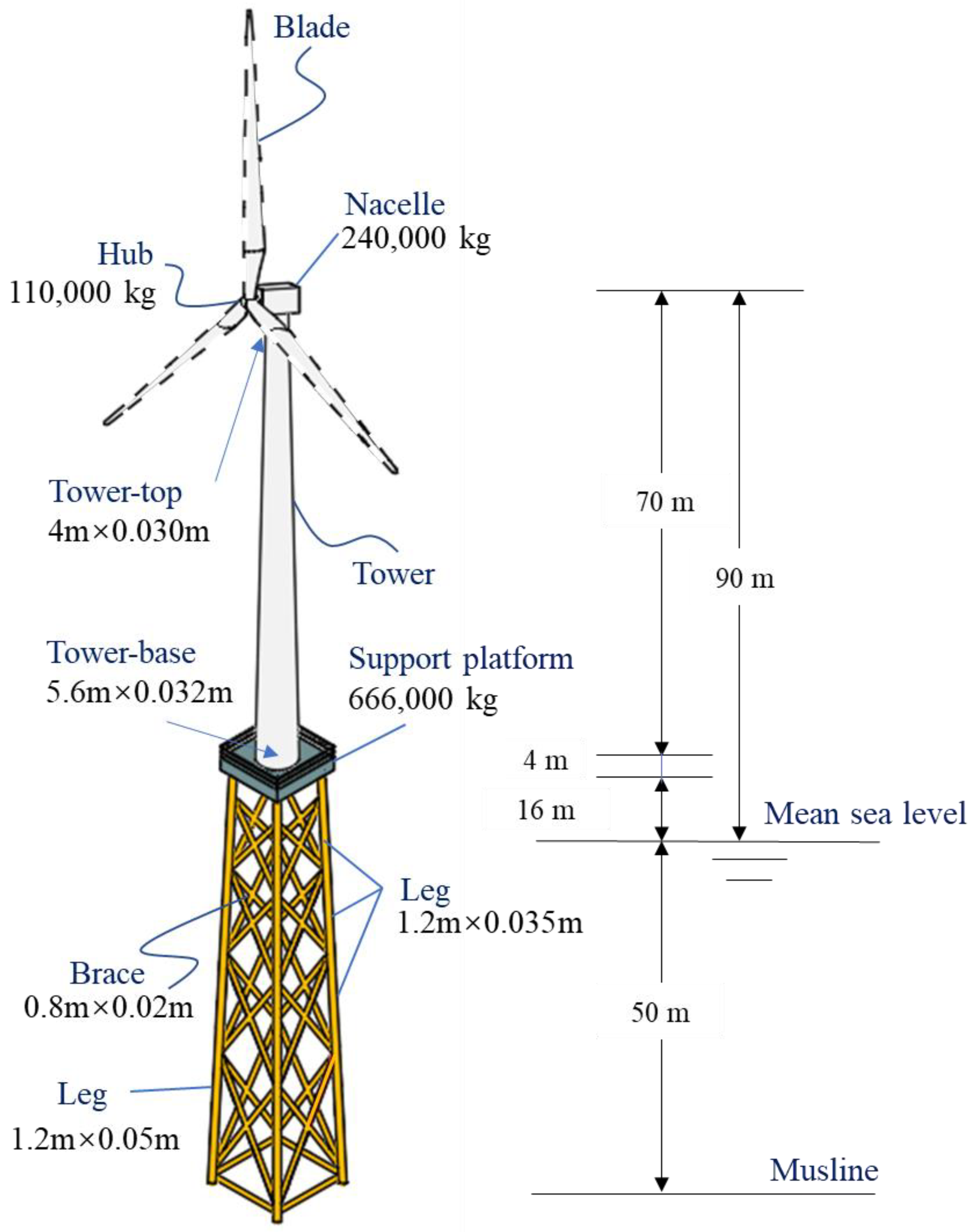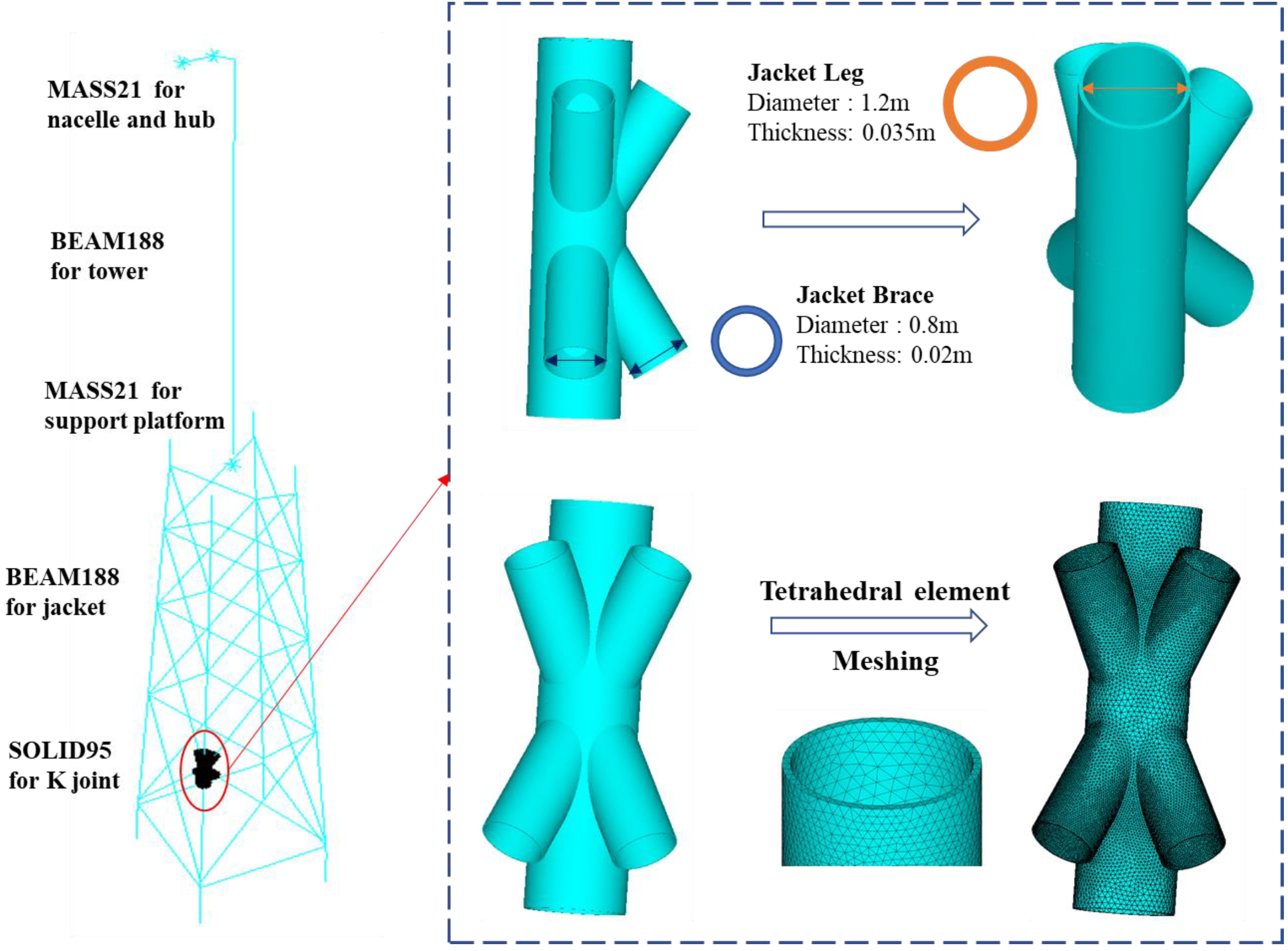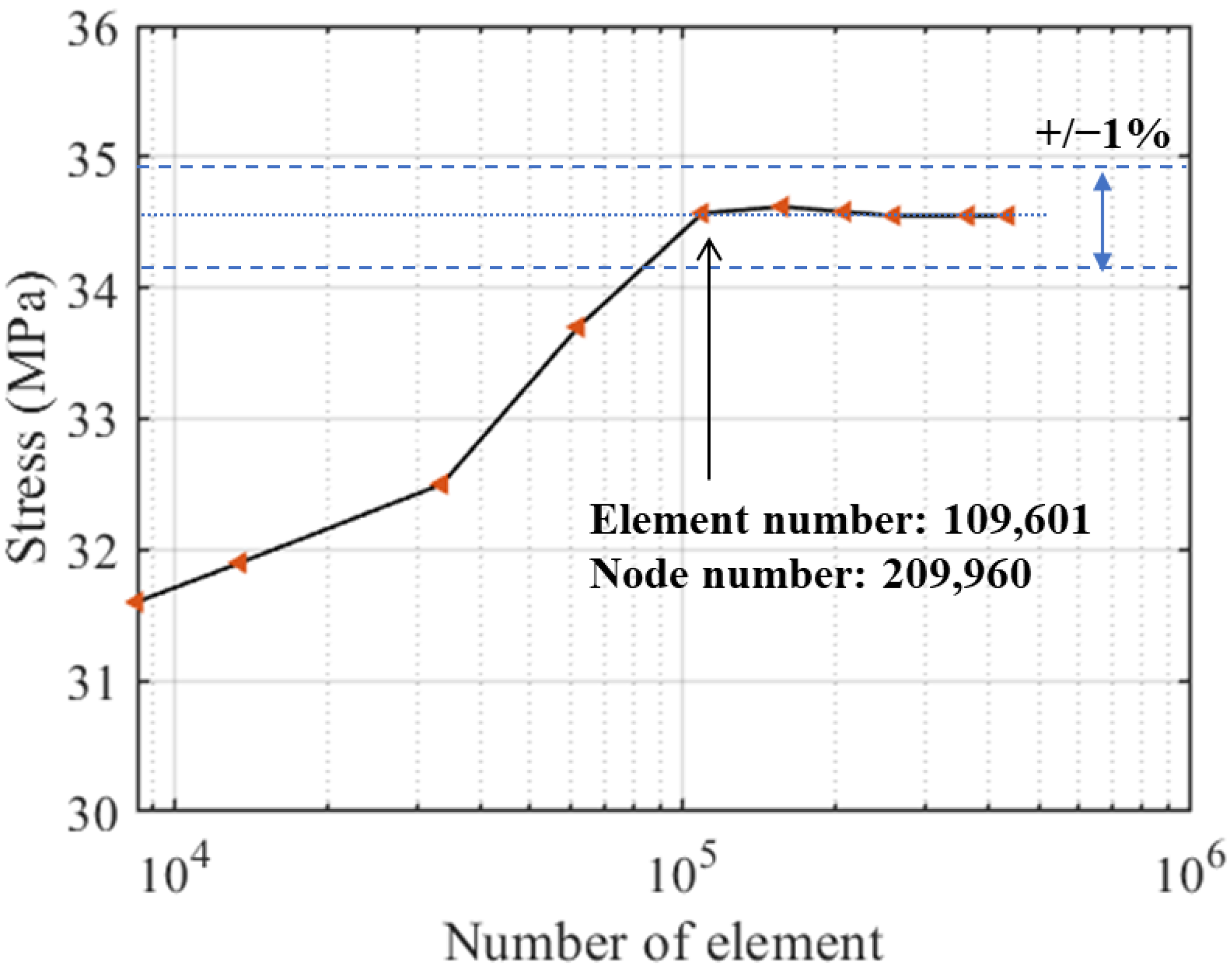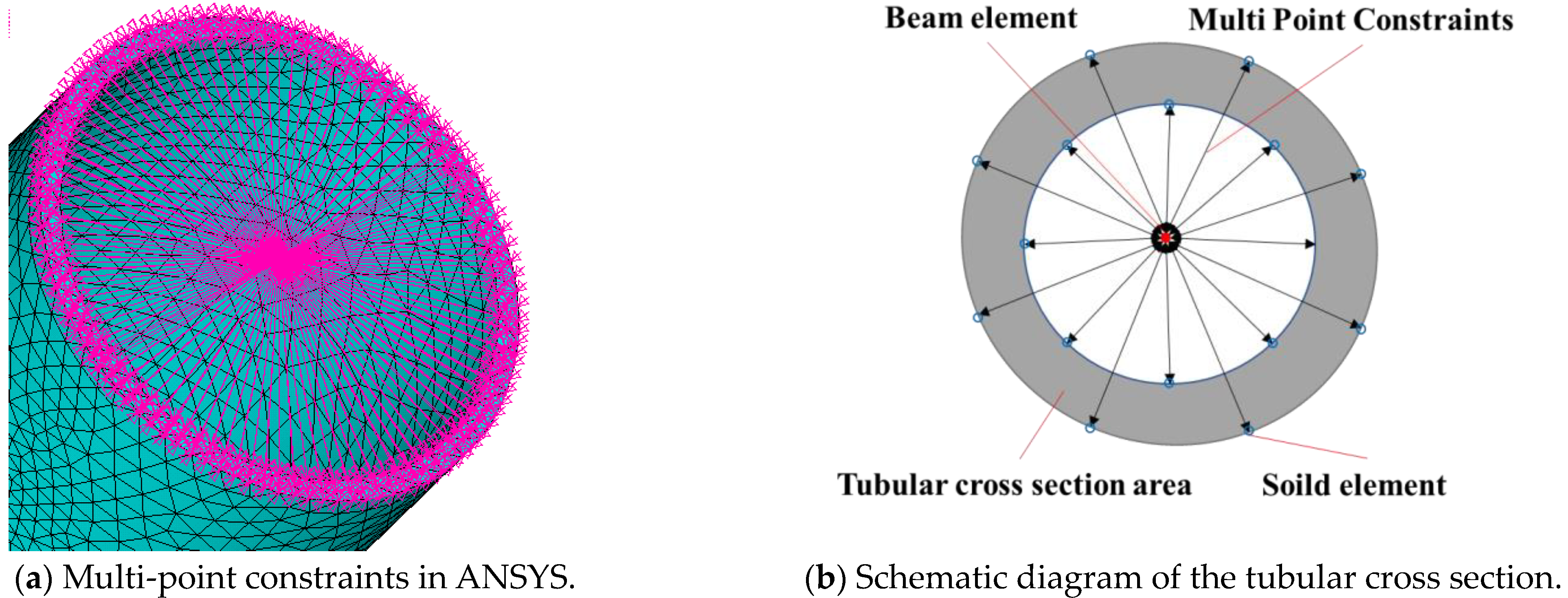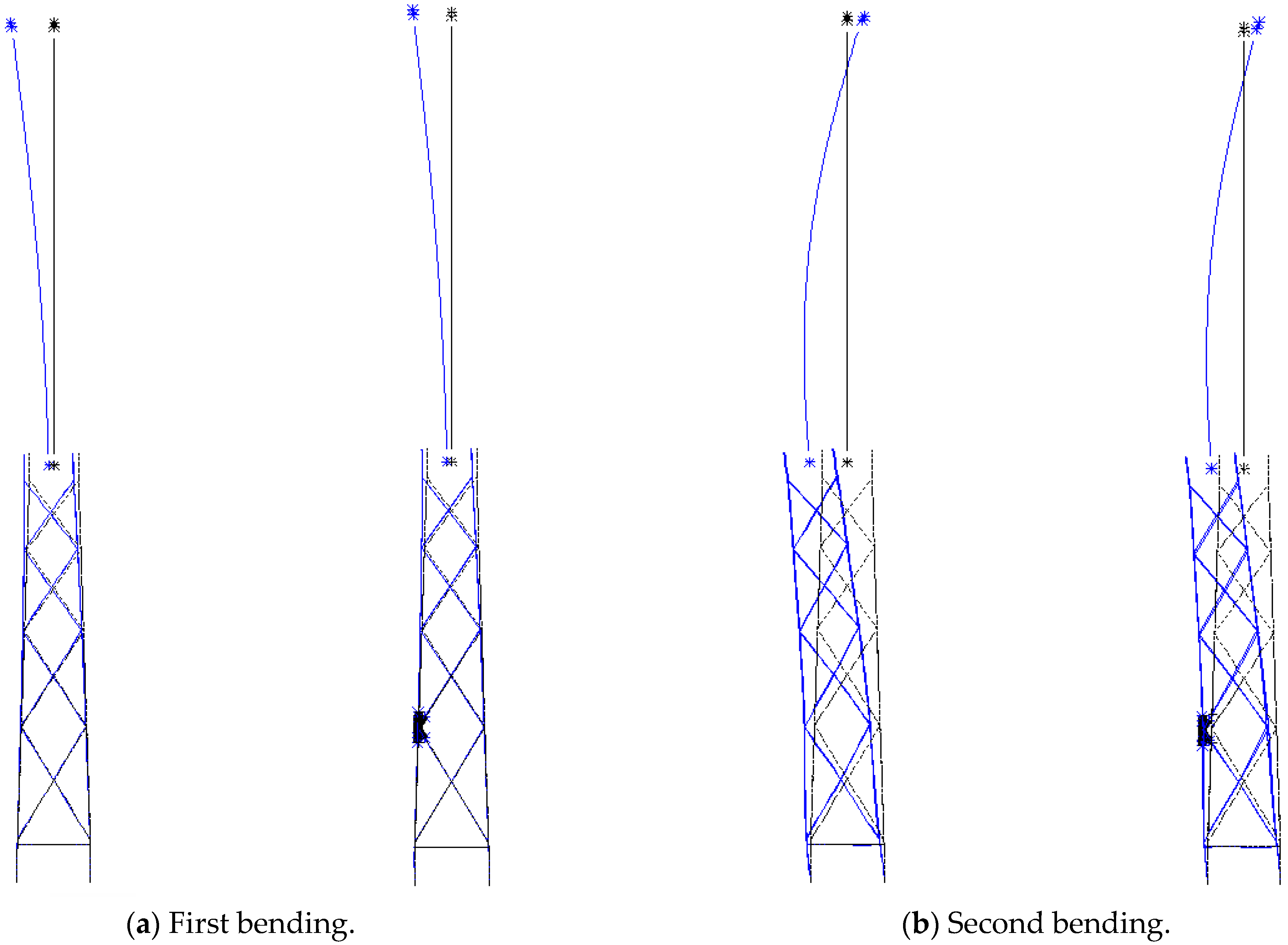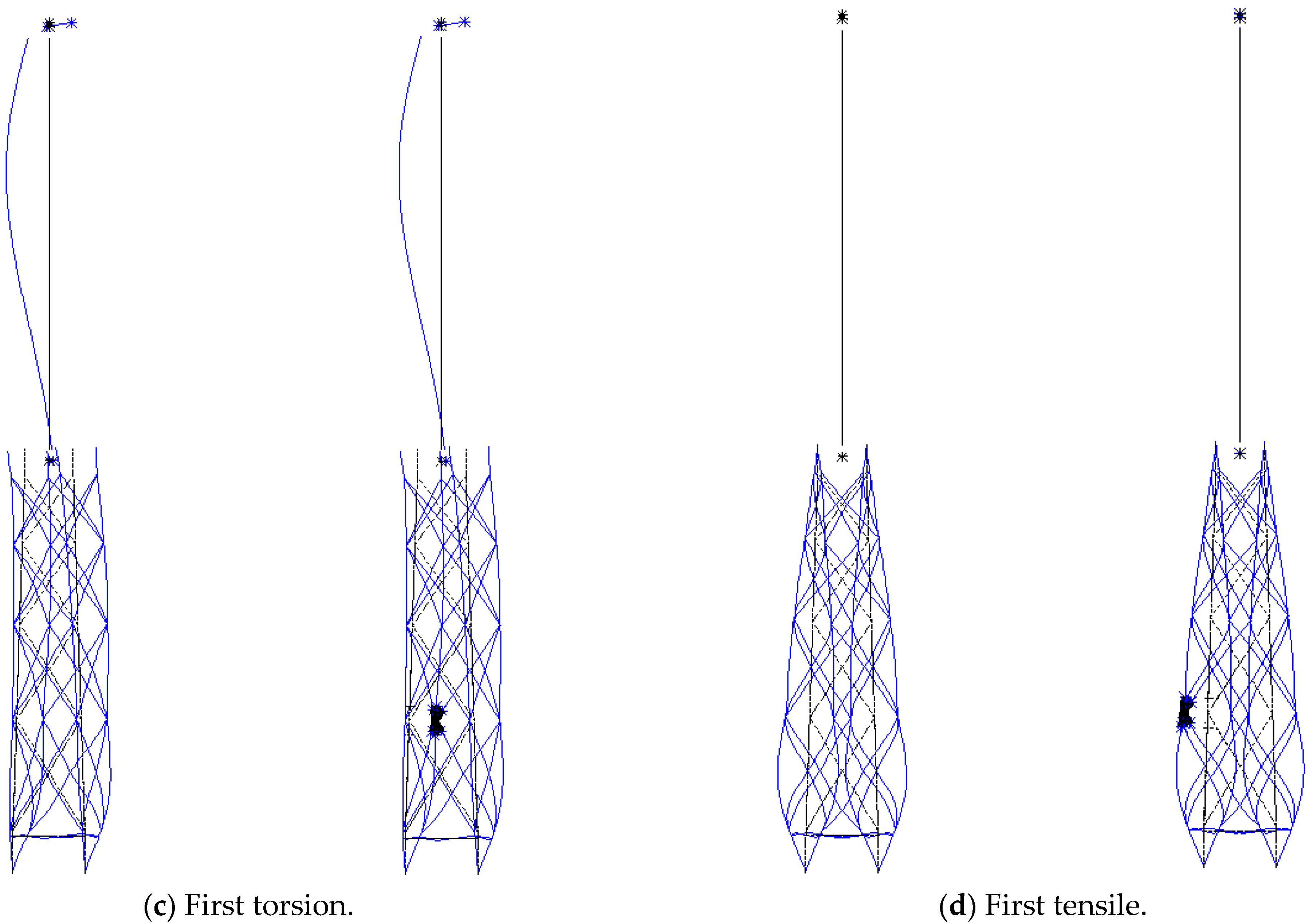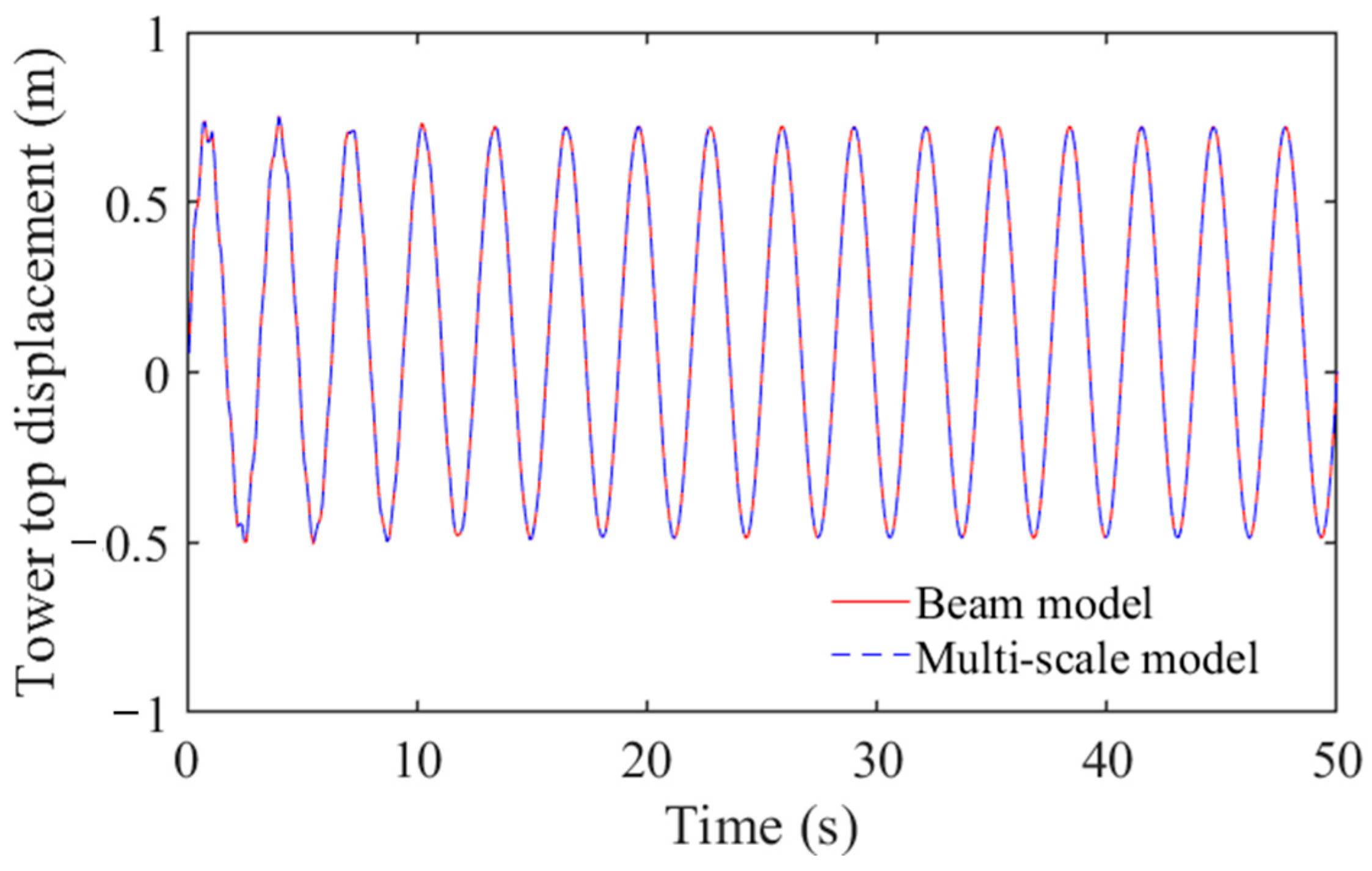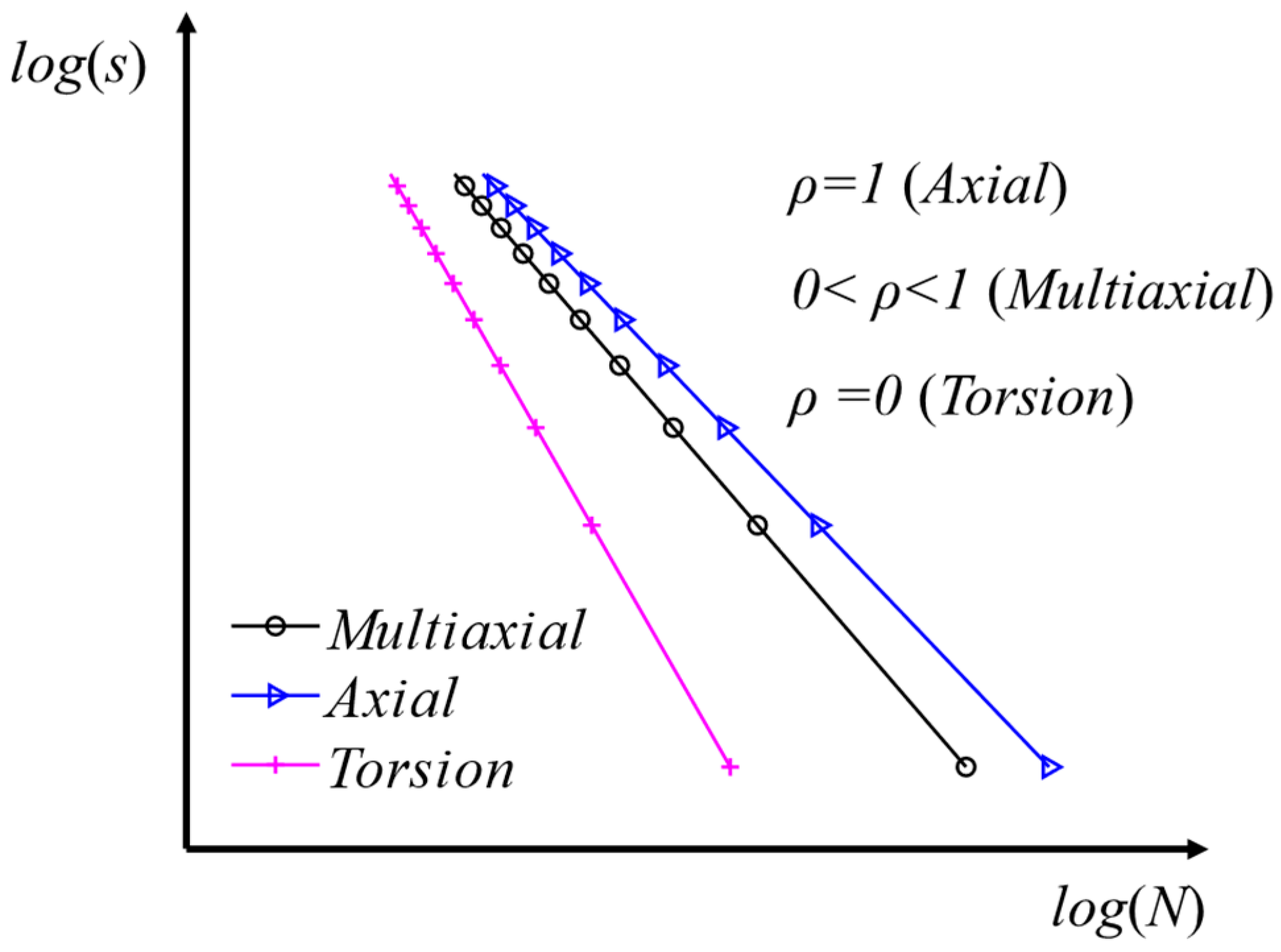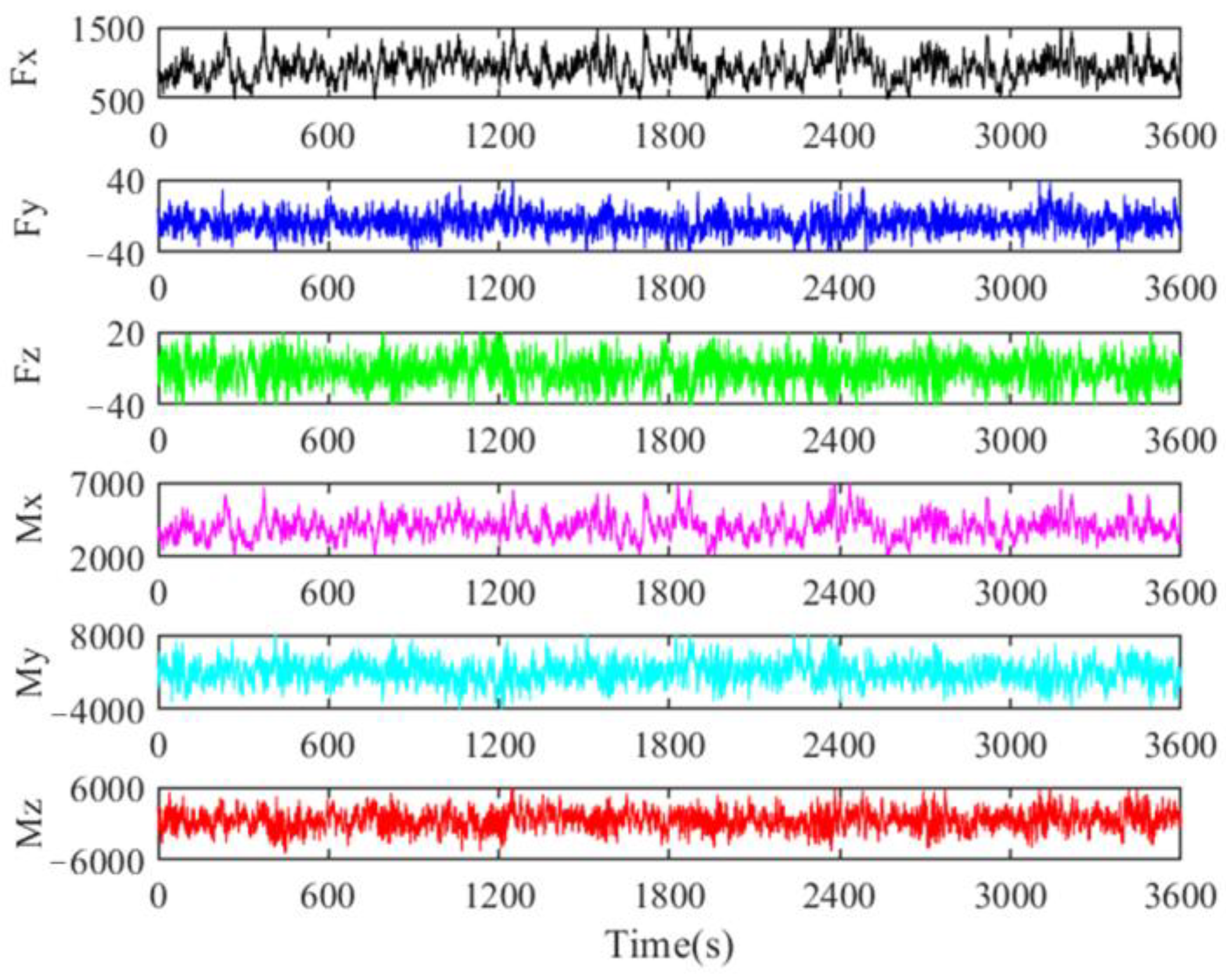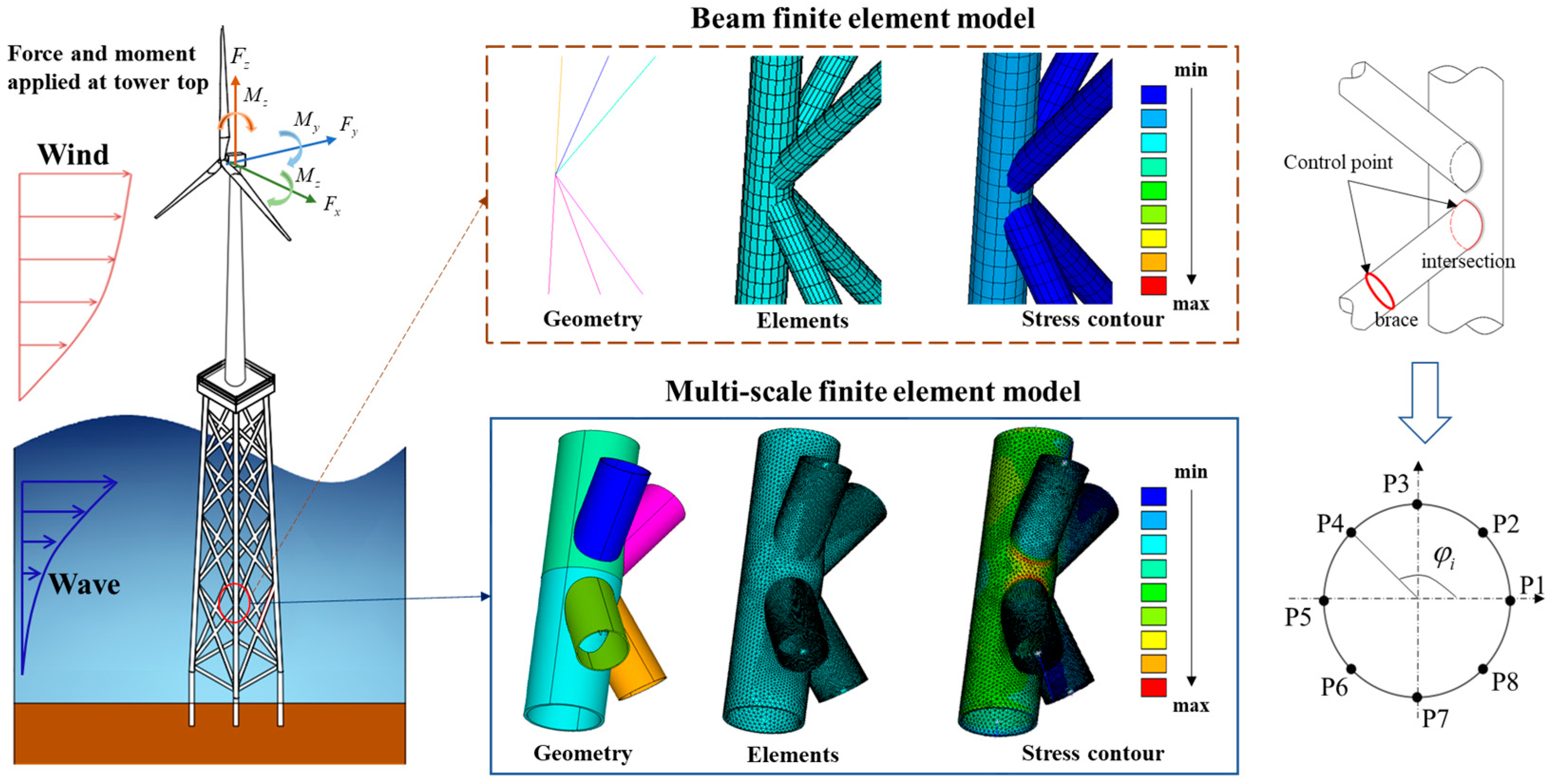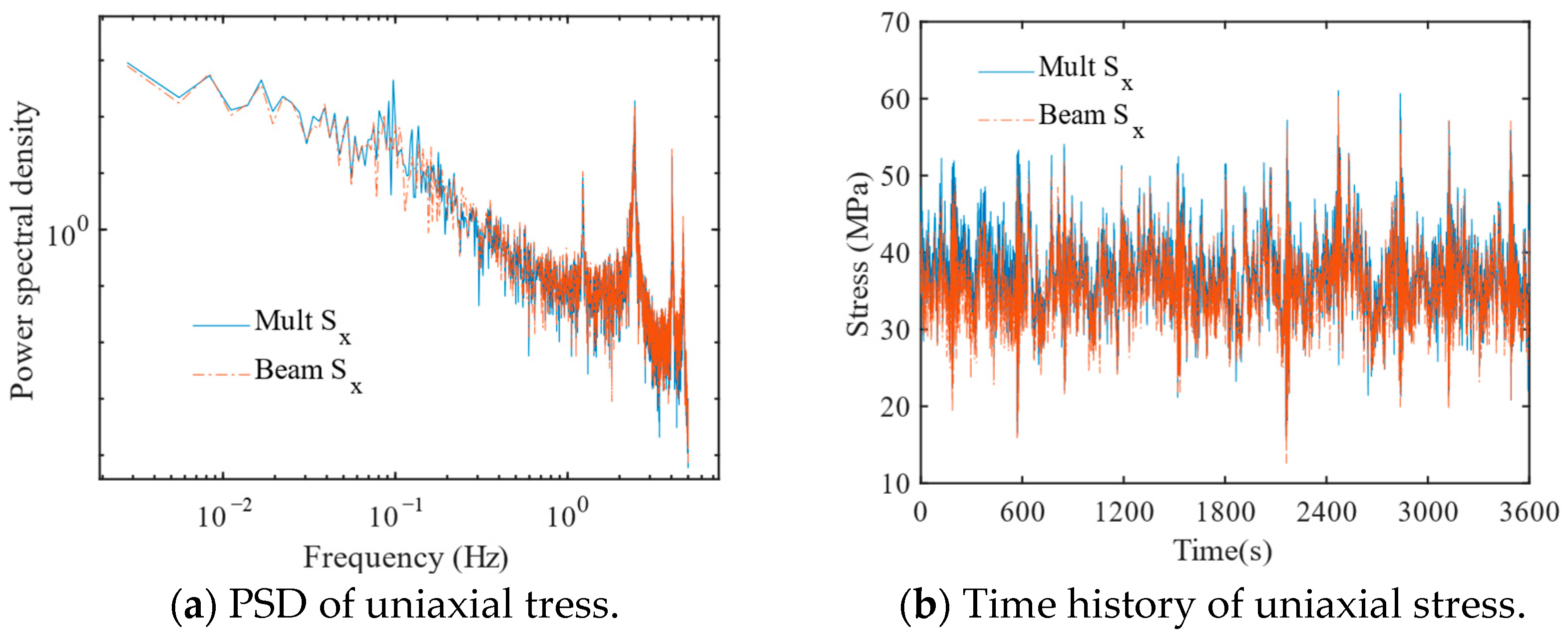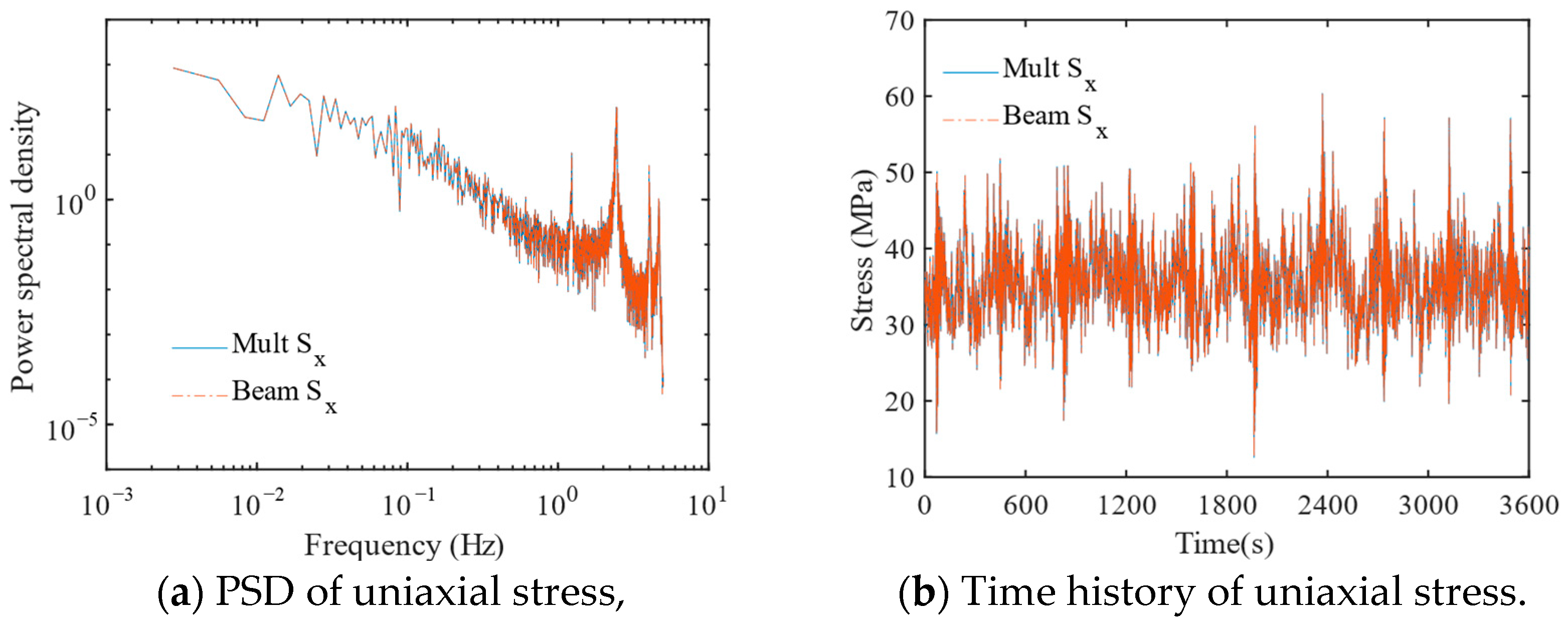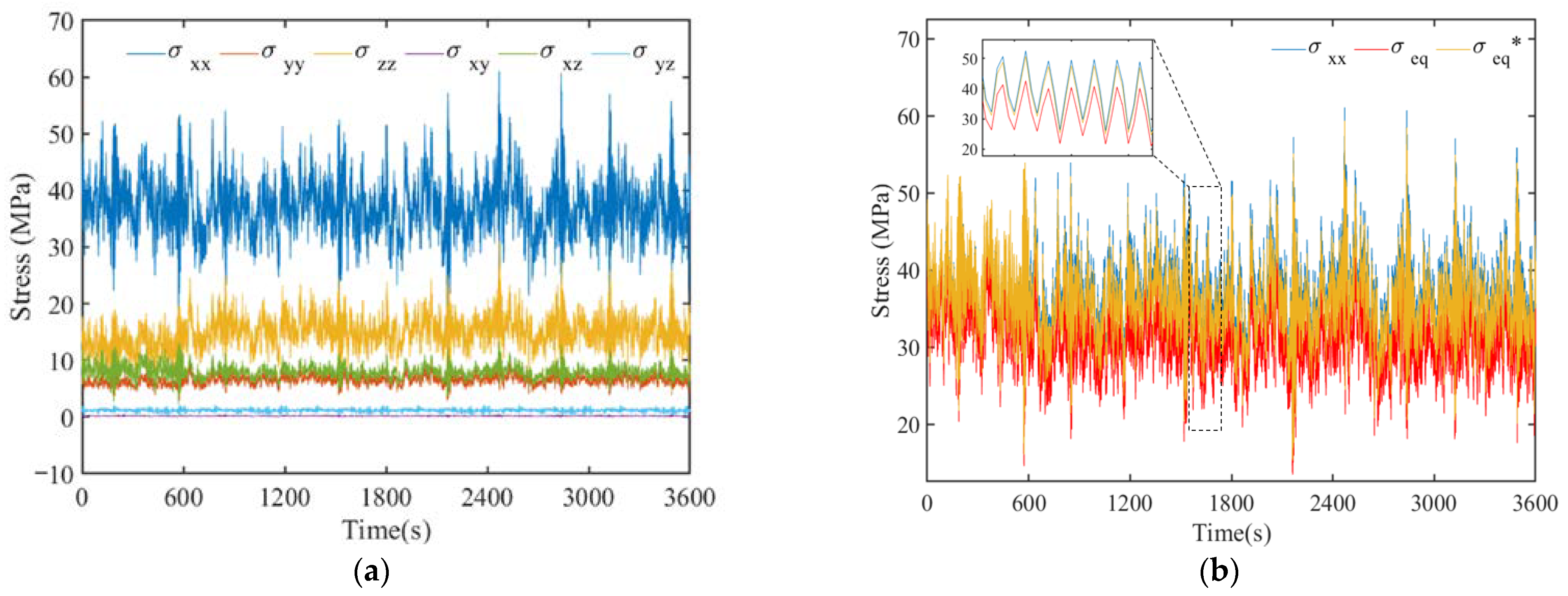1. Introduction
Wind energy is the fastest growing renewable energy source in the world, and offshore wind power has a high potential for development [
1,
2,
3]. Jacket-type support structures are an important part of offshore wind turbines [
4], and the tubular joints are susceptible to fatigue damage under the combined effects of wave and wind loads [
5].
There are usually two approaches to the structural analysis of jacket-type offshore wind turbines. One is the global finite element modeling to analyze from macroscopic scale [
6,
7]. The joints of global model are established using beam elements, ignoring the influence of nodal effects, such as the flexibility, geometry and weld configuration of its substructure joints [
8,
9]. The other is local modeling via small-scale analysis, and the local joint flexibilities of tubular K/DK-joints [
10,
11], T/Y-joints [
12,
13,
14], or X-joints [
15,
16] are established individually using solid or shell elements for analysis. For offshore structures subjected to typical wave and wind loading, local joints are difficult to determine the boundary conditions, ignoring the coordination between the global model and local model.
Multi-scale finite element simulation can provide a better solution in this regard. Small-scale solid elements are used to simulate local joints, while large-scale beam elements are used to simulate other components in the structure. This multi-scale model can capture not only the global structural behavior in terms of displacements and accelerations, but also the local nodal behavior in terms of stresses and strains without huge computational costs. Wang et al. [
17] developed a multi-scale model to analyze the failure analysis of transmission tower structures under the action of down-strike storm currents. Zhu et al. [
18] applied the multi-scale model to the structural health monitoring of cable-stayed bridges. Fang et al. [
19] established a multi-scale finite element model for the fatigue assessment of a welded beam-to-column connection in a steel tall building. Jan Dubois et al. [
20] took advantage of an accurate description of local joint behaviors using super-elements, enabling more accurate load simulations. The key issue of multi-scale finite element simulation is the coupling of different scale elements, e.g., the beam, shell and solid, at the interface. Several researchers have provided various coupling constraint methods, such as the Lagrange multiplier method, penalty method, transition element method and multi-point constraint method [
21,
22].
Jacket-type offshore wind turbines are subjected to complex environmental loads, and the joint fatigue problem is prominent under wind and wave loads. Some scholars have carried out fatigue analysis work on the tubular joints of jacket structures, but only a few studies has been performed on the multiaxial fatigue behavior of offshore wind turbines [
23,
24,
25,
26]. However, due to the complexity of the local shape of the structure, multiple external input loads and other factors, the K-type tubular joints of the jacket-type offshore wind turbine structure is often in a multiaxial stress state during service, which is actually a multiaxial fatigue problem [
27,
28]. Multiaxial fatigue analysis mainly includes two methods, one is based on the static strength theory method, and the other is the critical plane method. The von Mises equivalent stress method based on the static strength theory is commonly used in the engineering field [
29,
30,
31], but it ignores the effect of hydrostatic pressure, which has been shown to have an important effect on fatigue [
32,
33]. Ge et al. [
34] proposed an improved Lemaitre equivalent multiaxial stochastic fatigue estimation method. The method is used to consider the effect of hydrostatic pressure based on stress invariants and also to introduce a multiaxial
S–N curve to predict the multiaxial fatigue damage of structures.
As can be seen in this review of existing literature, only a few studies have been performed on the multiaxial fatigue behavior of jacket-type offshore wind turbines, and most have dealt with the conventional beam elements model. Although the multi-scale method is used in a variety of large-scale structural calculations, its application to the structural analysis of jacket-type offshore wind turbines is still lacking. The offshore wind turbines are subjected to aerodynamic loads based on the quasi-steady blade element momentum theory and the hydrodynamic loads based on the Morrison equation, resulting in complex stress states at local joints. Therefore, multi-scale finite element models are urgently needed for structural dynamic analysis, and multiaxial fatigue methods need to be considered for the fatigue damage assessment of tubular joints of the jacket. Via global and local cooperative analyses, the accuracy is improved without increasing the computational effort, which provides a new idea for engineering pre-designs.
In this study, the multi-scale method is employed to jacket-type offshore wind turbine finite element models, and multi-point constraint equations are used for the interface coupling of different scale elements. To verify the multi-scale finite element model, modal analysis is performed. The fatigue damage results of multi-scale model and beam model are evaluated. Multiaxial fatigue behavior of a jacket-type offshore wind turbine under wind and wave random loading was estimated, with particular attention being paid to the multi-scale model of a typical K-type tubular joint. The results of uniaxial and multiaxial fatigue damage are compared.
2. Reference Wind Turbine Model
The reference model of a 5-MW National Renewable Energy Laboratory (NREL) wind turbine [
35] is used for examples in many related studies, as shown in
Figure 1. The structure comprises the hub and nacelle, the tower, the support platform and the jacket-type foundation, whose major geometric and material parameters are given in
Table 1 and
Table 2, respectively. More details can be found in [
36].
2.1. Multi-Scale Modeling of the Jacket-Type Offshore Wind Turbine
The multi-scale finite element model of the jacket-type offshore wind turbine described above was built using commercial finite element software, ANSYS. Multi-scale finite element modeling requires the delineation of potential local failure regions and other parts of the global model, including the following three steps: the first step is to refine the local model using solid elements for the typical joint, the second step is to construct a global model using beam elements, and the third step is to couple the global and local models using constraint equations to integrate the multi-scale model.
Firstly, a local model was established to determine the fatigue failure control point of the structure. For the sake of a clear demonstration, only one typical and most important joint was selected to construct a detailed local model. Referring to the work by Wei and Yuan [
37], it is generally considered that the most severe plastic damage occurs in the third and fourth X frame levels of the jacket. Therefore, the K-type tubular joint, as shown in
Figure 2, was selected as the fatigue control location for fatigue damage analysis. Higher-order SOLID95 elements, which can simulate irregular shapes with no loss in accuracy, were used to model the selected joint.
After local modeling, global modeling was performed by using BEAM188 elements to simulate all other components. Different from the conventional beam elements model, the global model of multi-scale finite element model has a blank space in the local joint position. The literature shows that the effect of brace length on the stiffness of the multi-scale model is negligible when the model length is about 2.5 times larger than the brace diameter [
20]. In addition, the nacelle, hub and support platform were reduced to mass points using MASS21 elements, respectively. Finally, in order to couple the global beam model and the local solid model, multi-point constraint equations were derived based on the virtual work principle to achieve a displacement (strain)-compatible and force (stress) equilibrium at the coupled interface. The displacement constraint equations for coupling the beam and solid models are given in [
38].
In order to perform mesh sensitivity analysis, several models of the local K-type tubular joint with different number of elements were analyzed. The results in
Figure 3 show that meshes with approximate 109,601 elements are both behaviorally and computationally efficient for the K-type tubular joint using tetrahedral element shapes. The beam element size was meshed to 0.5 m according to [
36]. Therefore, the multi-scale finite element model of the jacket wind turbine has 1942 beam elements, 109,601 solid elements and a total of 213,797 nodes.
2.2. Multi-Point Constraints
Multi-scale interface coupling is the key to establishing a multi-scale model of the structure. In the multi-scale model of a jacket-type offshore wind turbine, the coupling between beam element and solid element needs to be considered. Due to the different number of element degrees of freedom, the nodes of beam element have six directional degrees of freedom (three translational displacement ones, Ux, Uy and Uz, and three rotational ones, Rx, Ry and Rz), and the nodes of the solid element have three directional translational degrees of freedom, Ux, Uy and Uz. Therefore, the multi-scale model of an offshore wind turbine needs to consider the coupling of degrees of freedom and implement it in the finite element solution.
Multi-scale model interface coupling is achieved by means of multi-point constraint equations, as shown in
Figure 4. The multi-point constraint method is considered to be an attractive coupling method based on the force and displacement constraint equations used to couple elements of different scales. The constraint equations for the interface coupling are expressed as the nodal displacements of the beam elements equal to the generalized displacements at the interfaces of the solid elements as follows:
where
ub and
us denote the nodal displacement vectors of the beam model and solid model interfaces, respectively, and
C is the constraint equation coefficient matrix.
2.3. Modal Analysis and Validation via Natural Frequency Comparison
In order to verify the accuracy of the multi-scale finite element model of the jacket-type offshore wind turbine structure, modal analysis was performed and compared with the results calculated using the BeamDyn module of FAST. The BeamDyn module uses the finite element for modeling, and is considered to be the most professional simulation and analysis software for wind turbine calculation at present [
30]. The structural models were established in three different ways, i.e., the beam element model was established using FAST software, and the simplified beam model and multi-scale model were established using commercial finite element software. The modal analysis takes FAST calculation results as the standard and analyzes the relative errors of simplified beam model and multi-scale model using commercial finite element software ANSYS. Damping has significant influence on the dynamic response of the jacket-type offshore wind turbine. The Rayleigh damping with a damping ratio of 1% is applied to all modes in this study [
35].
The results of the first eight-order modal vibration model calculation comparison are shown in
Table 3. The lower-order modes of three finite element models are basically the same, and the maximum relative errors of 8.98% and 8.74% appear in the higher-order modes of the left and right bending of the structure, respectively. The reason for this analysis is that the low-order vibration shape indicates the overall characteristics of the structure, and the high-order vibration shape reflects the local characteristics of the structure, and there are slight differences between the local locations of the FAST model and the commercial software beam model. Meanwhile, the results show that the free vibration frequencies of the multi-scale model and the beam model are in good agreement with the difference of less than 9%.
Figure 5 provide a comparison between the first bending, second bending, first torsion and tensile modal shape as calculated by ANSYS. Starting with the torsional modal shape, the deformation is dominated by the local diagonal bracing members of the jacket-type offshore wind turbine structure. The multi-scale finite element model is basically consistent with the beam model for each order mode shape.
To include the effect of damping, forced vibration analysis was performed. The harmonic load with excitation amplitude of 2000 KN and a frequency of 0.32 Hz was given at the top of the tower. The results in
Figure 6 show that the displacement responses at the top of the tower under forced vibration in both models match well. Via modal analysis and forced vibration analysis, the multiscale model was verified for subsequent numerical research.
5. Conclusions
In this paper, multiaxial fatigue damage analysis based on a multi-scale finite element model is applied to jacket-type offshore wind turbines under wind and wave loads. The typical K-type tubular joint of jacket considering local features are simulated using small-scale solid elements, and other components are simulated using beam elements. The results of the multi-scale model compared with the beam model show that the point uniaxial fatigue damage at the intersection of the conduit leg and diagonal brace differs by 15%, and the point damage at the diagonal brace is well matched. The reason for this is that the multi-scale model considers the connection characteristics and local geometric features of the K-type tubular joint, and the effect of higher-order modal shape on the statistical properties of the dynamic time history (e.g., skewness and variance). It implies that the multi-scale finite element model is essential for fatigue damage analysis applied at typical joints, while the accuracy of the beam model is sufficient for non-concerning regions of other members.
In addition, multiaxial fatigue damage based on a multi-scale finite element model was analyzed. Multiaxial S–N curves were introduced using two equivalent stresses (i.e., Mises and Lemaitre) methods for multiaxial fatigue damage analysis. Based on the multi-scale finite element model, the uniaxial and multiaxial fatigue damage was compared at three representative points. The results show that compared with uniaxial fatigue damage, the difference of multiaxial von Mises equivalent method is about 10%, and the difference of multiaxial Lemaitre equivalent method considering hydrostatic pressure is about 14%. Especially when the uniaxial stress component is dominant, the difference between uniaxial and multiaxial fatigue damage is reduced to 6~13%. However, when other stress components dominate, the difference of multiaxial fatigue damage results reaches 70~80%, and multiaxial stress state is not negligible. It is suggested that the multi-scale finite element model should be applied to typical joints of jacket-type offshore wind turbines under wind and wave random loading for multiaxial fatigue analysis to improve the accuracy of analysis.
